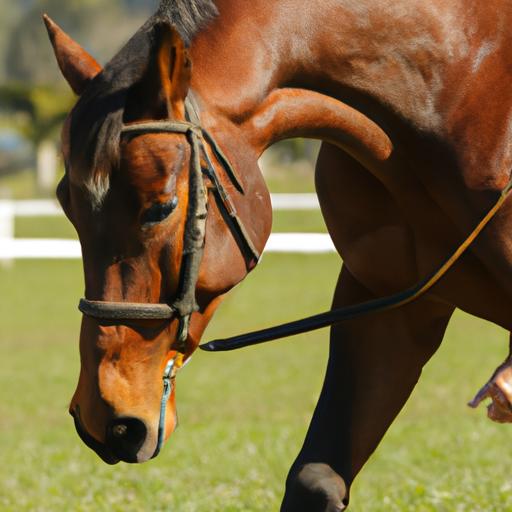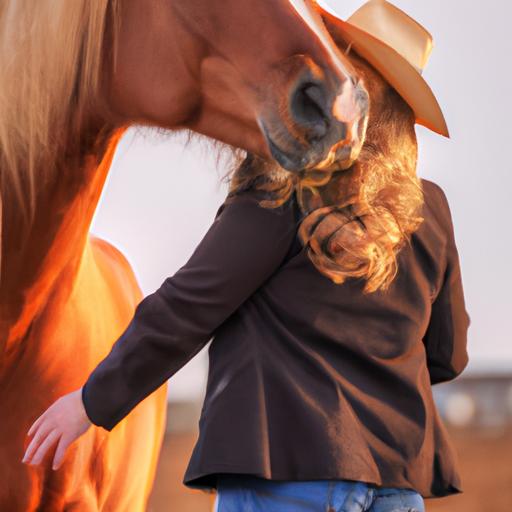Unlock the true potential of your equine partnerships with instinctive horse training. Overcome behavioral challenges and develop patience for effective training.
Introduction

Have you ever marveled at the natural grace and intuition of horses? The ability to forge a deep connection, almost telepathic in nature, is at the heart of instinctive horse training. By tapping into their inherent instincts, we unlock their true potential as willing partners, leading to a harmonious and effective training experience. In this article, we will explore the importance and benefits of instinctive horse training, delve into its definition and explanation, and highlight the main keyword – “instinctive horse training.”
Importance and Benefits of Instinctive Horse Training
When it comes to training horses, traditional methods often focus solely on obedience and compliance. However, instinctive horse training takes a different approach, recognizing the innate instincts and behaviors of these magnificent creatures. By understanding their natural inclinations, we can work with them, rather than against them, creating a stronger foundation for trust and communication.
Through instinctive horse training, we establish a bond that transcends commands and cues, allowing for a deeper understanding of our equine partners. This method not only enhances the horse’s physical and mental well-being but also promotes a more enjoyable and fulfilling experience for both horse and trainer. Through this unique approach, we unlock their potential, fostering a partnership based on trust, respect, and mutual understanding.
Definition and Explanation of Instinctive Horse Training
Instinctive horse training is a philosophy that acknowledges and utilizes the natural instincts and behaviors of horses in the training process. It embraces their innate ability to communicate through body language, non-verbal cues, and herd dynamics. By working with their instincts rather than attempting to suppress or override them, we create a harmonious training environment where horses can thrive.
In instinctive horse training, we prioritize positive reinforcement techniques, rewarding desired behaviors and encouraging the horse’s willingness to participate. This approach emphasizes understanding and empathy, allowing us to guide the horse’s learning process while respecting their individuality. By embracing their instincts and aligning our training methods accordingly, we unlock their true potential, paving the way for a fulfilling partnership.
In the next section, we will delve into the key principles of instinctive horse training, further exploring the building blocks of this transformative approach. Let’s embark on this journey together, where horses become more than just our companions – they become our trusted partners in horsemanship.
Stay tuned for Section II: Understanding Instinctive Horse Training.
Understanding Instinctive Horse Training
Exploring the Natural Instincts and Behavior of Horses
Horses are remarkable creatures, guided by a set of natural instincts and behaviors that have evolved over centuries. Understanding these instincts is crucial for successful instinctive horse training. Horses are prey animals, which means they have a strong flight response and a heightened sense of awareness. They are social animals, relying on a hierarchical herd structure for safety and survival. By delving into their instincts, we gain valuable insight into their behavior and can adapt our training methods accordingly.
How Instinctive Horse Training Taps into These Instincts
Instinctive horse training works in harmony with a horse’s natural instincts, rather than against them. It recognizes that horses are highly perceptive and responsive to non-verbal communication, such as body language and energy. Through this approach, we aim to establish a level of trust and respect that allows the horse to feel safe and comfortable in our presence.
By understanding the horse’s instinctual responses, we can shape our training techniques to align with their natural inclinations. For example, we can use pressure and release methods to mimic the herd dynamics, where a dominant horse applies pressure to guide the actions of a subordinate. By applying this principle, we can effectively communicate our expectations to the horse without resorting to force or intimidation.
Establishing a Strong Bond and Communication with Horses
Instinctive horse training places great emphasis on building a strong bond and effective communication between horse and trainer. This requires patience, consistency, and a willingness to listen and understand from both parties. By acknowledging the horse’s unique personality and adapting our approach accordingly, we create a foundation of trust that forms the basis of a successful partnership.
Through instinctive horse training, we learn to “speak horse” by observing their body language, subtle cues, and responses. We develop a heightened sense of awareness and attunement, allowing us to communicate with the horse on a deeper level. This mutual understanding fosters a connection that goes beyond commands and cues, leading to a harmonious and cooperative relationship.
In the upcoming section, we will delve into the key principles that underpin instinctive horse training, providing a roadmap for successful training sessions. Let’s explore the essence of this transformative approach and discover the secrets to unlocking the true potential of our equine partners.
Stay tuned for Section III: Key Principles of Instinctive Horse Training.
Key Principles of Instinctive Horse Training
Developing Trust and Respect
In instinctive horse training, building a foundation of trust and respect is paramount. Horses are incredibly perceptive creatures, attuned to our intentions and emotions. By cultivating a relationship based on trust, we create an environment where the horse feels safe, valued, and understood.
Building trust begins with consistent and clear communication. We must be mindful of our body language, as horses are highly responsive to our non-verbal cues. By maintaining a calm and confident demeanor, we convey a sense of leadership and establish ourselves as a trustworthy guide.
Respect is equally crucial in this partnership. It involves recognizing the horse as an individual, honoring their boundaries, and never resorting to force or intimidation. By treating them with kindness and patience, we earn their respect in return, fostering a bond built on mutual admiration.
Using Body Language and Non-Verbal Cues
In the realm of instinctive horse training, words matter less than actions. Horses are masters of body language, relying on subtle cues to communicate with one another. As trainers, we must learn to speak their language, using our own body language to convey our intentions and desires.
By paying close attention to our posture, facial expressions, and energy levels, we can effectively communicate with horses. For instance, a relaxed and open posture signifies trust, while a tense or closed-off stance may elicit anxiety or resistance. By mirroring their movements and using consistent cues, we establish a clear line of communication that transcends verbal commands.
Employing Positive Reinforcement Techniques
Gone are the days of dominance-based training methods. Instinctive horse training emphasizes positive reinforcement as a powerful tool for shaping desired behaviors. By rewarding the horse’s efforts with praise, treats, or physical affection, we motivate them to engage in the desired behavior willingly.
Positive reinforcement encourages the horse to actively participate in the training process, making it a joyful experience for both horse and trainer. By focusing on what the horse does well and building upon those successes, we create a positive learning environment that nurtures their confidence and eagerness to learn.
In the upcoming section, we will explore various techniques for instinctive horse training, providing you with practical tools to implement these key principles effectively. Ready to take your training to the next level? Let’s dive in!
Stay tuned for Section IV: Techniques for Instinctive Horse Training.
Section IV: Techniques for Instinctive Horse Training
Groundwork Exercises: Establishing a Solid Foundation
Before embarking on any training journey, laying a solid foundation is essential. Groundwork exercises serve as the building blocks for a successful partnership with your horse. These exercises allow you to establish trust, respect, and clear communication from the ground up.
Begin with simple exercises such as leading, halting, and backing up. Focus on teaching your horse to respond to your body language and cues, reinforcing the importance of your role as a leader. Gradually introduce more advanced exercises, such as lunging and desensitization, to further develop their responsiveness and confidence.
Building a Strong Partnership through Liberty Training
Liberty training, also known as working at liberty, is a remarkable way to deepen the connection and bond with your horse. This technique involves working with your horse without any physical restraints, such as halters or ropes. Instead, you rely on trust, body language, and mutual understanding.
Start in a secure and enclosed area, gradually removing any physical constraints. Focus on building trust through positive reinforcement and clear communication. As your horse learns to follow your cues, you can engage in intricate movements, such as circles, changes of direction, and even jumping obstacles, all while maintaining a harmonious connection.
Incorporating Natural Horsemanship Methods in Training Sessions
Natural horsemanship methods align perfectly with instinctive horse training, as they prioritize understanding and communication over force and dominance. This approach emphasizes building a partnership based on trust, respect, and empathy.
Incorporate techniques such as join-up, where you establish leadership by guiding your horse through different gaits and directions, and the use of pressure and release to encourage desired responses. Working with the horse’s instincts, rather than against them, allows for a more effective and harmonious training experience.
By implementing these techniques into your instinctive horse training sessions, you will create a solid foundation, establish a strong partnership, and foster a deep connection with your equine companion. As we move forward, we will address the challenges that may arise during this training journey and provide you with valuable tips for success.
Stay tuned for Section V: Overcoming Challenges in Instinctive Horse Training.
Conclusion
In conclusion, instinctive horse training offers a transformative approach to building a strong and harmonious partnership with our equine companions. By understanding and working with their natural instincts, we create a training environment based on trust, respect, and effective communication.
Through this method, we address common behavioral issues in horses and develop strategies to overcome fear, aggression, and resistance. Patience and consistency are key in establishing a solid foundation for success. By embracing the principles of instinctive horse training, we unlock the true potential of our equine partners, fostering a deep bond and mutual understanding.
If you are ready to embark on this incredible journey of horsemanship, I encourage you to explore instinctive horse training further. Seek professional guidance, attend workshops, and continue expanding your knowledge. Remember, every horse is unique, and it takes time and dedication to develop a true partnership based on trust and respect.
At Horsemasterypro.com, we are committed to providing you with valuable resources and guidance on instinctive horse training. Visit our website to discover more insights, techniques, and success stories from the world of horsemanship. Together, let’s unlock the full potential of the human-horse connection and create a harmonious partnership that transcends expectations.
Unlock the power of instinctive horse training today and witness the magic that unfolds in the bond between you and your equine partner.
Visit Horsemasterypro.com to take the next step on your journey towards horsemanship excellence.
Remember, the journey is as beautiful as the destination.
Let’s create a world of harmony and understanding between humans and horses.
See you on the other side of horsemanship mastery!


